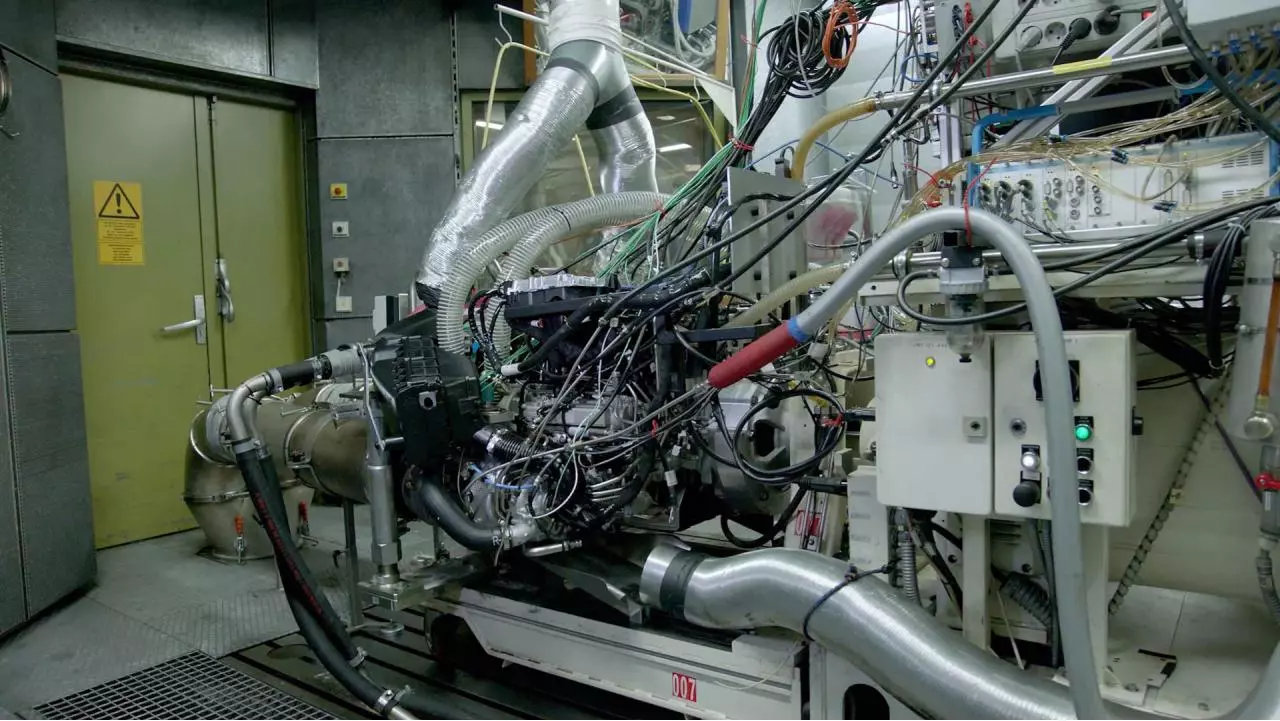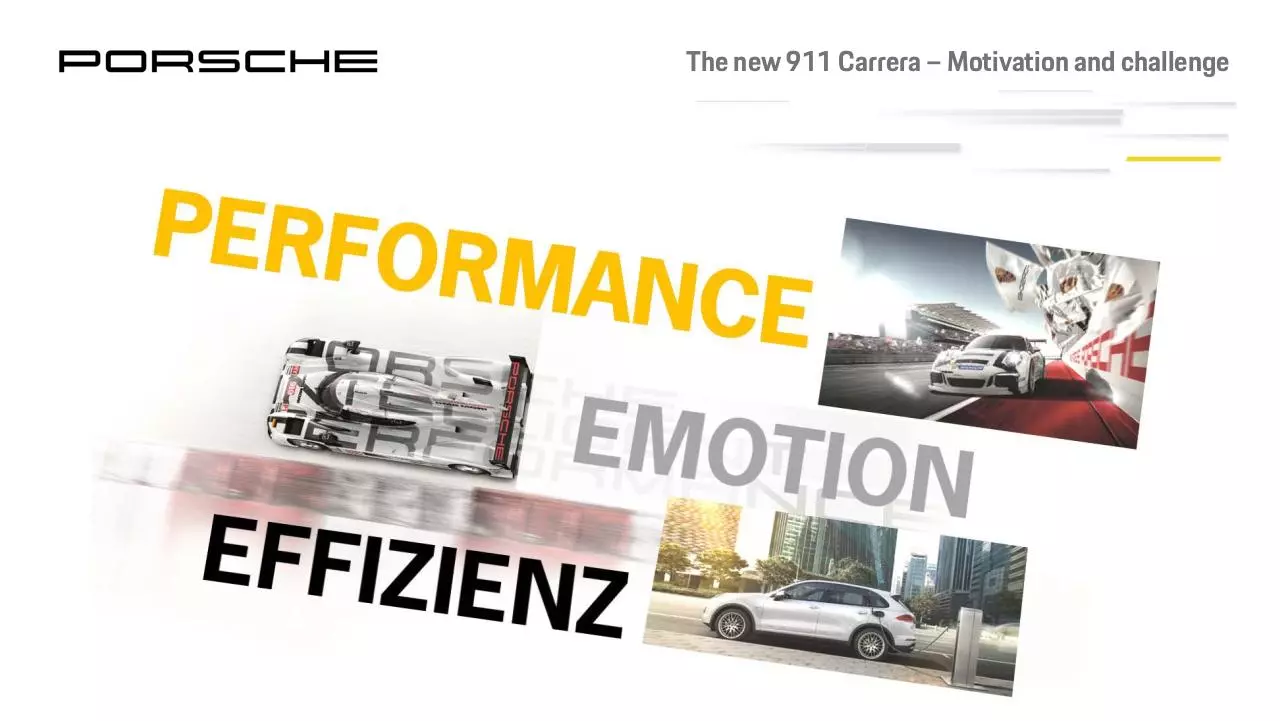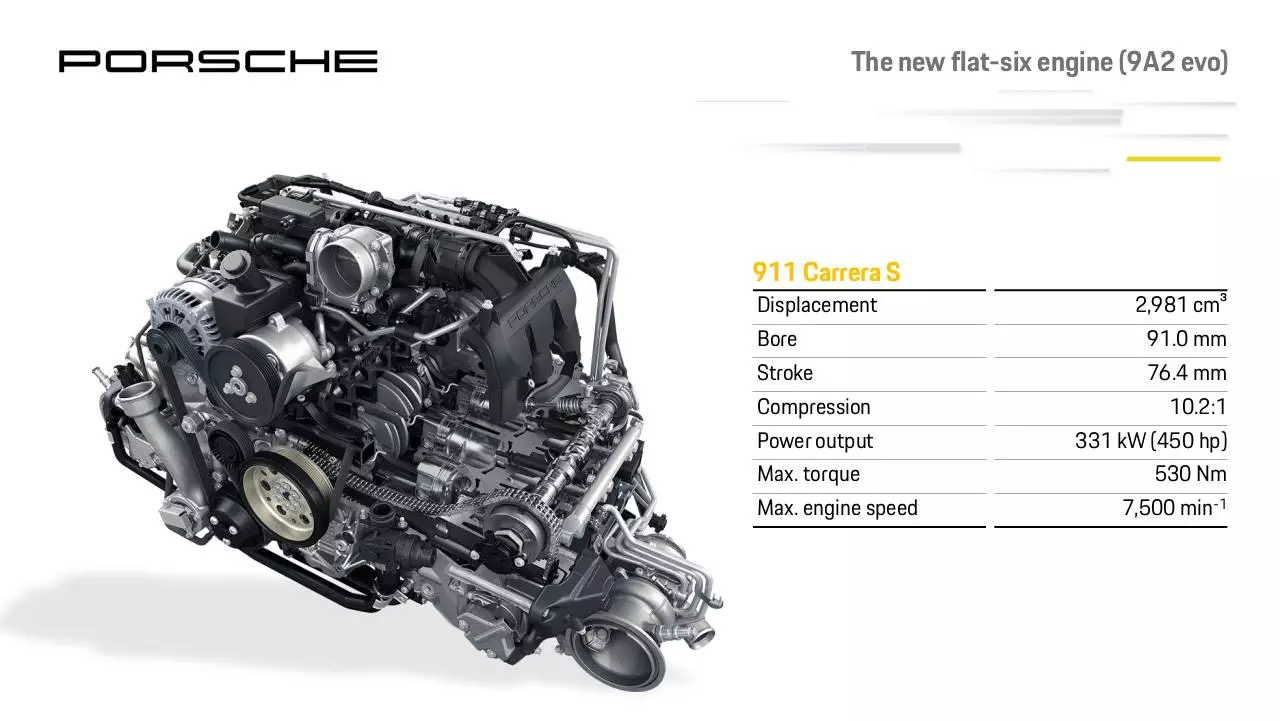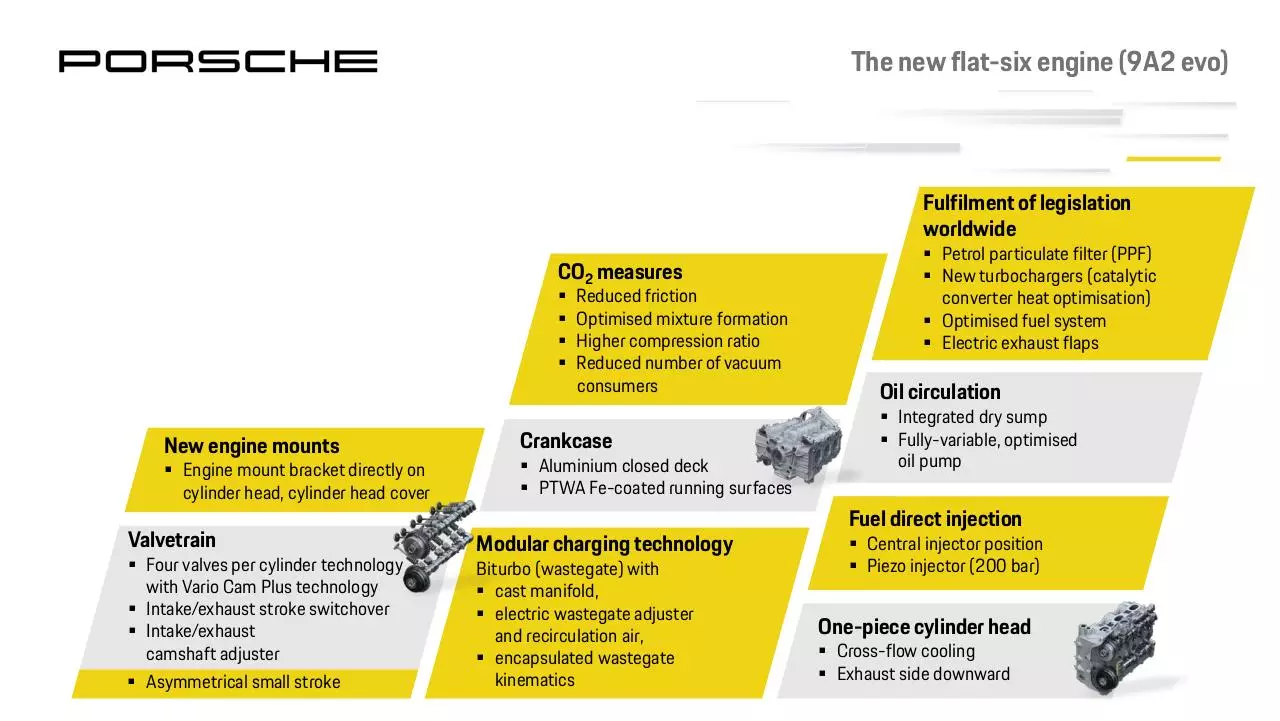TWS 992 Powertrain EN (PDF)





File preview
The new 911 Carrera
Technology Workshop
Powertrain
The new 911 Carrera – Motivation and challenge
The new flat-six engine (9A2 evo)
911 Carrera S
Displacement
2,981 cm³
Bore
91.0 mm
Stroke
76.4 mm
Compression
10.2:1
Power output
331 kW (450 hp)
Max. torque
Max. engine speed
530 Nm
7,500 min-1
The new flat-six engine (9A2 evo)
Fulfilment of legislation
worldwide
CO2 measures
New engine mounts
Engine mount bracket directly on
cylinder head, cylinder head cover
Valvetrain
Four valves per cylinder technology
with Vario Cam Plus technology
Intake/exhaust stroke switchover
Intake/exhaust
camshaft adjuster
Asymmetrical small stroke
Reduced friction
Optimised mixture formation
Higher compression ratio
Reduced number of vacuum
consumers
Crankcase
Aluminium closed deck
PTWA Fe-coated running surfaces
Modular charging technology
Biturbo (wastegate) with
cast manifold,
electric wastegate adjuster
and recirculation air,
encapsulated wastegate
kinematics
Petrol particulate filter (PPF)
New turbochargers (catalytic
converter heat optimisation)
Optimised fuel system
Electric exhaust flaps
Oil circulation
Integrated dry sump
Fully-variable, optimised
oil pump
Fuel direct injection
Central injector position
Piezo injector (200 bar)
One-piece cylinder head
Cross-flow cooling
Exhaust side downward
The new 911 Carrera – Optimised combustion method
Piezo injector (A-nozzle)
Multiple injections possible (up to 5)
High-quality atomisation and rate of evaporation – good mixture
formation even with very late injection
Precise metering of small volumes and high flow-through
Asymmetrical (small) valve stroke
Optimised Vario Cam Plus valve timing with different valve strokes of
2 mm and 4.5 mm for the small stroke.
Intake valve can close earlier dethrottling
Higher compression
Effective compression increase
Efficiency boost, smooth running, lower emissions
The new 911 Carrera – New turbocharging
Symmetrical turbocharger layout
Electric wastegate
Optimised catalytic converter intake flow
Turbine wheel 48 mm (+ 3 mm)
Compression wheel 55 mm (+ 4 mm)
New exhaust manifold
Cast iron manifold instead of sheet metal
Air cooled instead of air gap insulated
Lower full-load fuel consumption
Better cold-start heating of catalytic converter
Faster response of turbochargers
The new 911 Carrera – New turbocharging
Exhaust air mass flow, catalytic converter inflow (wastegate 37.5° open, catalytic converter heating)
Velocity
high
low
The new 911 Carrera – Intercooling
992
991 II
Intercooler
Intercooler
Higher cooling air throughput due to new position
14% bigger intercooling
50% dethrottled process air path
The new 911 Carrera – particulate filter (PF)
PF integrated in tight engine compartment
No noticeable effects for customer
Exhaust back-pressure is compensated
Emotional sound
The new 911 Carrera – Optimised engine mounts
991 II
Engine blade
Soft mount via bracket on crankcase
992
Engine bracket
Stiff/short mount via cylinder head
Engine mount shifted forward
Potential for PADM and chassis tuning
can be better exploited
Spread between better ride comfort and more sportiness
has been further increased
The new 911 Carrera – Power/torque
650
360
600
340
550
320
500
300
450
280
400
260
350
240
300
220
250
200
200
180
150
160
100
50
0
1000
1500
2000
2500
3000
3500
4000
4500
Engine speed [rpm]
5000
911 Carrera S (992) – 331 kW (450 hp)/530 Nm
140
911 Carrera S (991 II) – 309 kW (420 hp)/500 Nm
120
5500
6000
6500
7000
100
7500
Power [kW]
Torque [Nm]
Comparison of 3.0-litre B6 Biturbo 991 II vs. 992
The new eight-speed Porsche dual-clutch transmission
Efficiency
Performance
Comfort
Modularity
The new eight-speed PDK – Key characteristics
Efficiency
Performance
Comfort
Eight speeds with an 8.06 spread of ratios
Optimised shifting strategy
System pump
with demand-based control
New low-viscosity
transmission fluids
Optimisation of efficiency
(dual clutch, synchronisation,
hydraulics, direct lubrication,
seals, etc.)
Hybridisation option
Torque capacity > 800 Nm
Actuating torque of up to 1000
Nm in differential lock control
3-fold synchronisations of gears
1-4 for enhanced shifting
performance
Improved speed shift
Wet Mode
Full shift-by-wire
Starting performance
with engine speed control
Modularity
Modular transmission system
First use in Panamera
(gear set and hydraulics concept,
dual clutch family, shifting
actuators, pump, etc.)
Also used in Group vehicles
Other uses in 911 derivatives
The new eight-speed PDK – Gear set
Input shafts
Main shaft 1
Main shaft 2
Pinion shaft
Front axle output
Summation shaft
Four-shaft gear set
Separate reverse gear
Reverse gear shaft
Separate pinion shaft
Front axle output via spur gear stage
The new eight-speed PDK – Gear set
Controlled torque vectoring
Input shaft 2
Input shaft 1
Main shaft 2
Front axle output
Crown
wheel
Summation shaft
Pinion shaft
Differential
Main shaft 1
Reverse gear shaft
Parking lock
The new eight-speed PDK – Gear set
Multiple use of gears
6/8 and 5/7
Input shaft 2
Summation shaft
(K3 meshes with K1 and K2)
Cardan shaft to front axle drive
K3
8
4
K2
3
7
Main shaft 2
Engine
Input shaft 1
6
to differential
2
K1 1
5
Main shaft 1
Separate
pinion shaft
K4
R
Separate
R-gear shaft
8 gears
Unlimited direct
shift matrix
Flexible gear ratio
selection
Gear ratios of the 911 Carrera S (991 II) with seven-speed PDK
8000
7000
Engine speed [1/min]
6000
5000
4000
vmax = 306 km/h
3000
2000
1000
Spread: 6.28
0
0
50
100
150
200
Speed [km/h]
250
300
350
Gear ratios of the 911 Carrera S (992) with eight-speed PDK
8000
7000
Engine speed [1/min]
6000
5000
4000
vmax = 308 km/h
3000
First gear is defined for maximum starting performance
Ride comfort and improved fuel economy in overdrive gears 7 & 8
2000
Optimal gear ratio progression up to v_max gear (6 + 2 layout)
1000
Spread: 8.06
6.28
0
0
50
100
150
200
Speed [km/h]
250
300
350
The new eight-speed PDK – Structure
Dual clutch (wet)
Shifting actuator
Direct lubrication
Hydraulic control
Vane pump (variable)
The new eight-speed PDK – Innovative pump concept
Adjustable vane pump to control
volume flow (engine-driven)
Very low hydraulic energy consumption
Allows strategies (Normal, Sport, Sport Plus)
Losses 77% lower than 1st generation
Auxiliary gerotor pump
Lubrication and cooling of gear set
Tandem layout via Oldham clutch
37% lower losses compared to 1st PDK
The new eight-speed PDK – Optimised shifting strategy
Optimisation
of existing functions
Adapts to driving style,
driving situation and environment
Special functions for low friction
(wheel slip and yaw rate)
Support of PSM control interventions
Use of predictive information
from ACC and route data
Information on traffic ahead
Road classes and municipalities
Junctions
Predicted inclines
Distance to next bend
Predicted transverse acceleration (bend
curvature and vehicle speed)
Functions based
on predictive data
a) Use of engine overrun instead of
upshifting with slow-moving
vehicle ahead
b) Upshift preventer
before start of hill
c) Earliest possible upshifting
at end of a hill
d) Driving style / sport factor
Quicker reduction of sport factor when
“long straight section” is detected
Sport factor is limited
in muncipalities
e) Bend upshift preventer
with approaching bend
The new eight-speed PDK – Optimised shifting strategy
information
ute data
ties
n (bend
a) Slower vehicle ahead
Functions based
on predictive data
a) Use of engine overrun
insteadofof
thrust instead
upshifting
upshifting with
with slow-moving
slow-moving
vehicle ahead
Upshift preventer
b) Start of hill
Upshift preventer
d) Driving style // sport factor
factor
Quicker reduction of sport factor
factorwhen
when
“long straight section”
section”is
is detected
detected
Sport factor is limited
limited
built-up areas
in municipalities
e) Bend upshift preventer
preventer
with approaching
approaching bend
bend
Downshift
Upshift
Upshift preventer
preventer
b) Upshift
before
before start
start of
ofhill
hill
c) Earliest possible
possible upshifting
upshifting
at end of a hill
Speed-delta distance
c) End of hill
Upshift
Upshift
d) Straight section / within municipalities
Faster reduction
of sport factor
e) Bend ahead
Upshift preventer
Upshift
Downshift
The new PDK – Summary
The new eight-speed PDK in the 911 –
important component of a future-oriented drivetrain
The new front axle drive in the 911 Carrera 4S
Efficiency
Performance
Driving fun
The new front axle drive in the 911 Carrera 4S
Efficiency
Performance
Electromechanically
controlled hang-on all-wheel drive
Torque boost to max. torque transfer at front wheels
Plate heat exchanger to increase cooling performance
Need-based control of cooling
Moderate effort
Enables strategies
(Normal, Sport, Sport Plus)
New low-viscosity
transmission fluid
Optimisation of efficiency
(Bearings, lubrication, seals,
etc.)
Driving fun
Optimised central control strategy
Torque capacity +10 %
Cooling performance +300 %
Increased availability for brief,
high-energy inputs
Wet Mode
Rear-biased tuning
Longer system availability in
drift operation
Powertrain of the 911 Carrera – Summary
New front axle
drive
Optimised B6
biturbo engine with
optimised
combustion
Midpositioned
intercooler
New
eight-speed
PDK
New, higher
performance
engine cooling
New
turbocharging
Lateral air filters
Particulate filter
The new 911 Carrera – comparison to previous model
911 Carrera S (991 II)
911 Carrera S (992)
Improvement
Power output
309 kW (420 hp)
Torque
500 Nm
Top speed
306 km/h
Acceleration
0-100 km/h
3.9 s
Lap time Nürburgring –
Nordschleife [min]
7 min. 30 sec.
331 kW (450 hp)
+22 kW/30 hp (7.1 %)
+30 Nm (6.0 %)
308 km/h
+2 km/h (0.65 %)
0,0%
2,0%
4,0%
530 Nm
-0.4 s (10.3 %)
3.5 s
-5 s (0.7 %)
7 min. 25 sec.
6,0%
8,0%
10,0%
12,0%
Download TWS 992 Powertrain EN
TWS_992_Powertrain_EN.pdf (PDF, 3.6 MB)
Download PDF
This file has been shared publicly by a user of PDF Archive.
Document ID: 0001933490.